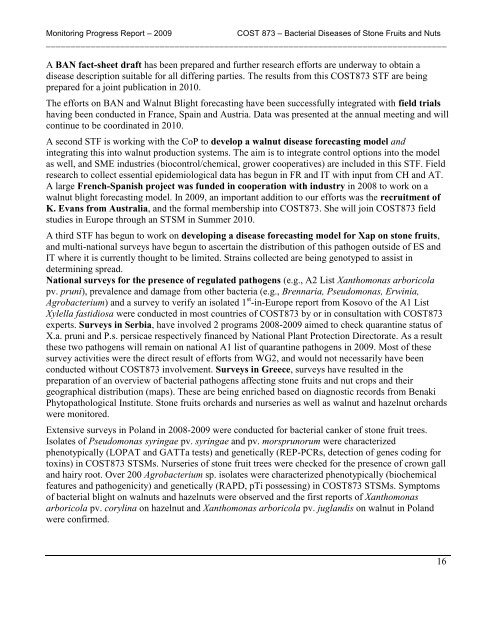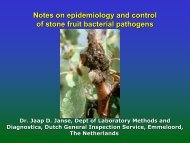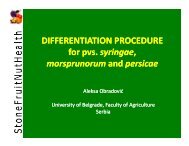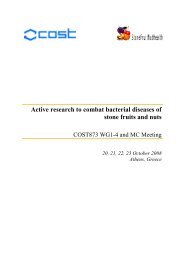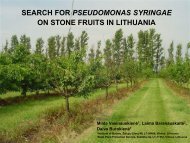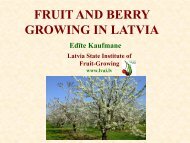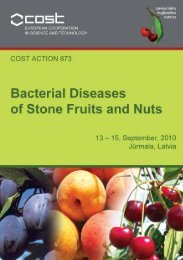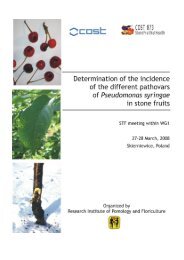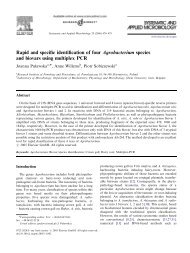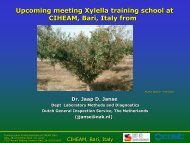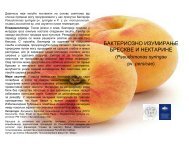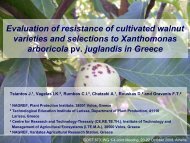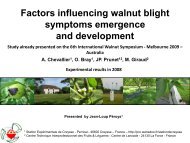Annual progress report - Cost 873
Annual progress report - Cost 873
Annual progress report - Cost 873
You also want an ePaper? Increase the reach of your titles
YUMPU automatically turns print PDFs into web optimized ePapers that Google loves.
Monitoring Progress Report – 2009<br />
COST <strong>873</strong> – Bacterial Diseases of Stone Fruits and Nuts<br />
_________________________________________________________________________________<br />
A BAN fact-sheet draft has been prepared and further research efforts are underway to obtain a<br />
disease description suitable for all differing parties. The results from this COST<strong>873</strong> STF are being<br />
prepared for a joint publication in 2010.<br />
The efforts on BAN and Walnut Blight forecasting have been successfully integrated with field trials<br />
having been conducted in France, Spain and Austria. Data was presented at the annual meeting and will<br />
continue to be coordinated in 2010.<br />
A second STF is working with the CoP to develop a walnut disease forecasting model and<br />
integrating this into walnut production systems. The aim is to integrate control options into the model<br />
as well, and SME industries (biocontrol/chemical, grower cooperatives) are included in this STF. Field<br />
research to collect essential epidemiological data has begun in FR and IT with input from CH and AT.<br />
A large French-Spanish project was funded in cooperation with industry in 2008 to work on a<br />
walnut blight forecasting model. In 2009, an important addition to our efforts was the recruitment of<br />
K. Evans from Australia, and the formal membership into COST<strong>873</strong>. She will join COST<strong>873</strong> field<br />
studies in Europe through an STSM in Summer 2010.<br />
A third STF has begun to work on developing a disease forecasting model for Xap on stone fruits,<br />
and multi-national surveys have begun to ascertain the distribution of this pathogen outside of ES and<br />
IT where it is currently thought to be limited. Strains collected are being genotyped to assist in<br />
determining spread.<br />
National surveys for the presence of regulated pathogens (e.g., A2 List Xanthomonas arboricola<br />
pv. pruni), prevalence and damage from other bacteria (e.g., Brennaria, Pseudomonas, Erwinia,<br />
Agrobacterium) and a survey to verify an isolated 1 st -in-Europe <strong>report</strong> from Kosovo of the A1 List<br />
Xylella fastidiosa were conducted in most countries of COST<strong>873</strong> by or in consultation with COST<strong>873</strong><br />
experts. Surveys in Serbia, have involved 2 programs 2008-2009 aimed to check quarantine status of<br />
X.a. pruni and P.s. persicae respectively financed by National Plant Protection Directorate. As a result<br />
these two pathogens will remain on national A1 list of quarantine pathogens in 2009. Most of these<br />
survey activities were the direct result of efforts from WG2, and would not necessarily have been<br />
conducted without COST<strong>873</strong> involvement. Surveys in Greece, surveys have resulted in the<br />
preparation of an overview of bacterial pathogens affecting stone fruits and nut crops and their<br />
geographical distribution (maps). These are being enriched based on diagnostic records from Benaki<br />
Phytopathological Institute. Stone fruits orchards and nurseries as well as walnut and hazelnut orchards<br />
were monitored.<br />
Extensive surveys in Poland in 2008-2009 were conducted for bacterial canker of stone fruit trees.<br />
Isolates of Pseudomonas syringae pv. syringae and pv. morsprunorum were characterized<br />
phenotypically (LOPAT and GATTa tests) and genetically (REP-PCRs, detection of genes coding for<br />
toxins) in COST<strong>873</strong> STSMs. Nurseries of stone fruit trees were checked for the presence of crown gall<br />
and hairy root. Over 200 Agrobacterium sp. isolates were characterized phenotypically (biochemical<br />
features and pathogenicity) and genetically (RAPD, pTi possessing) in COST<strong>873</strong> STSMs. Symptoms<br />
of bacterial blight on walnuts and hazelnuts were observed and the first <strong>report</strong>s of Xanthomonas<br />
arboricola pv. corylina on hazelnut and Xanthomonas arboricola pv. juglandis on walnut in Poland<br />
were confirmed.<br />
16


